Selective renal overexpression of human heat shock protein 27 reduces renal ischemia-reperfusion injury in mice
- PMID: 20484296
- PMCID: PMC2928523
- DOI: 10.1152/ajprenal.00194.2010
Selective renal overexpression of human heat shock protein 27 reduces renal ischemia-reperfusion injury in mice
Abstract
We have previously shown that exogenous and endogenous A(1) adenosine receptor (A(1)AR) activation protected against renal ischemia-reperfusion (IR) injury in mice by induction and phosphorylation of heat shock protein 27 (HSP27). With global overexpression of HSP27 in mice, however, there was a paradoxical increase in systemic inflammation with increased renal injury after an ischemic insult due to increased NK1.1 cytotoxicity. In this study, we hypothesized that selective renal expression of HSP27 in mice would improve renal function and reduce injury after IR. Mice were subjected to renal IR injury 2 days after intrarenal injection of saline or a lentiviral construct encoding enhanced green fluorescent protein (EGFP) or human HSP27 coexpressing EGFP (EGFP-huHSP27). Mice with kidney-specific reconstitution of huHSP27 had significantly lower plasma creatinine, renal necrosis, apoptosis, and inflammation as demonstrated by decreased proinflammatory cytokine mRNA induction and neutrophil infiltration. In addition, there was better preservation of the proximal tubule epithelial filamentous (F)-actin cytoskeleton in the huHSP27-reconstituted groups than in the control groups. Furthermore, huHSP27 overexpression led to increased colocalization with F-actin in renal proximal tubules. Taken together, these findings have important clinical implications, as they imply that kidney-specific expression of HSP27 through lentiviral delivery is a viable therapeutic option in attenuating the effects of renal IR.
Figures
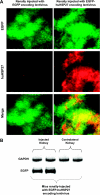


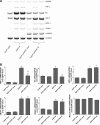
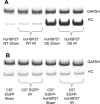
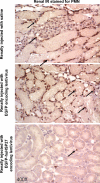
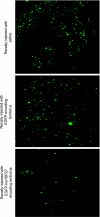
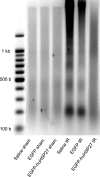

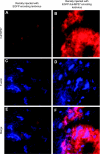
Similar articles
-
Sphingosine kinase 1 protects against renal ischemia-reperfusion injury in mice by sphingosine-1-phosphate1 receptor activation.Kidney Int. 2011 Dec;80(12):1315-27. doi: 10.1038/ki.2011.281. Epub 2011 Aug 17. Kidney Int. 2011. PMID: 21849969
-
Selective intrarenal human A1 adenosine receptor overexpression reduces acute liver and kidney injury after hepatic ischemia reperfusion in mice.Lab Invest. 2010 Mar;90(3):476-95. doi: 10.1038/labinvest.2009.143. Epub 2010 Jan 11. Lab Invest. 2010. PMID: 20065944
-
Human heat shock protein 27-overexpressing mice are protected against acute kidney injury after hepatic ischemia and reperfusion.Am J Physiol Renal Physiol. 2009 Oct;297(4):F885-94. doi: 10.1152/ajprenal.00317.2009. Epub 2009 Aug 5. Am J Physiol Renal Physiol. 2009. PMID: 19656912 Free PMC article.
-
Human heat shock protein 27 overexpressing mice are protected against hepatic ischemia and reperfusion injury.Transplantation. 2009 May 27;87(10):1478-87. doi: 10.1097/TP.0b013e3181a3c691. Transplantation. 2009. PMID: 19461484 Free PMC article.
-
Mice that overexpress human heat shock protein 27 have increased renal injury following ischemia reperfusion.Kidney Int. 2009 Mar;75(5):499-510. doi: 10.1038/ki.2008.572. Epub 2008 Nov 19. Kidney Int. 2009. PMID: 19020532 Free PMC article.
Cited by
-
Renal proximal tubular NEMO plays a critical role in ischemic acute kidney injury.JCI Insight. 2020 Sep 17;5(19):e139246. doi: 10.1172/jci.insight.139246. JCI Insight. 2020. PMID: 32941183 Free PMC article.
-
Protective effects of the AKT activator SC79 on renal ischemia-reperfusion injury.Int J Clin Exp Pathol. 2018 Sep 1;11(9):4571-4578. eCollection 2018. Int J Clin Exp Pathol. 2018. PMID: 31949855 Free PMC article.
-
Activators of G protein signaling in the kidney.J Pharmacol Exp Ther. 2015 May;353(2):235-45. doi: 10.1124/jpet.115.222695. Epub 2015 Jan 27. J Pharmacol Exp Ther. 2015. PMID: 25628392 Free PMC article. Review.
-
The Yin and Yang of Alarmins in Regulation of Acute Kidney Injury.Front Med (Lausanne). 2020 Aug 21;7:441. doi: 10.3389/fmed.2020.00441. eCollection 2020. Front Med (Lausanne). 2020. PMID: 32974364 Free PMC article. Review.
-
Mediators and mechanisms of heat shock protein 70 based cytoprotection in obstructive nephropathy.Cell Stress Chaperones. 2015 Nov;20(6):893-906. doi: 10.1007/s12192-015-0622-z. Epub 2015 Jul 31. Cell Stress Chaperones. 2015. PMID: 26228633 Free PMC article. Review.
References
-
- Arrigo AP, Firdaus WJ, Mellier G, Moulin M, Paul C, Diaz-Latoud C, Kretz-Remy C. Cytotoxic effects induced by oxidative stress in cultured mammalian cells and protection provided by Hsp27 expression. Methods 35: 126–138, 2005 - PubMed
-
- Bidmon B, Endemann M, Muller T, Arbeiter K, Herkner K, Aufricht C. HSP-25 and HSP-90 stabilize Na,K-ATPase in cytoskeletal fractions of ischemic rat renal cortex. Kidney Int 62: 1620–1627, 2002 - PubMed
-
- Bruey JM, Ducasse C, Bonniaud P, Ravagnan L, Susin SA, Diaz-Latoud C, Gurbuxani S, Arrigo AP, Kroemer G, Solary E, Garrido C. Hsp27 negatively regulates cell death by interacting with cytochrome c. Nat Cell Biol 2: 645–652, 2000 - PubMed
Publication types
MeSH terms
Substances
Grants and funding
LinkOut - more resources
Full Text Sources
Other Literature Sources
Medical
Molecular Biology Databases
Research Materials
Miscellaneous

